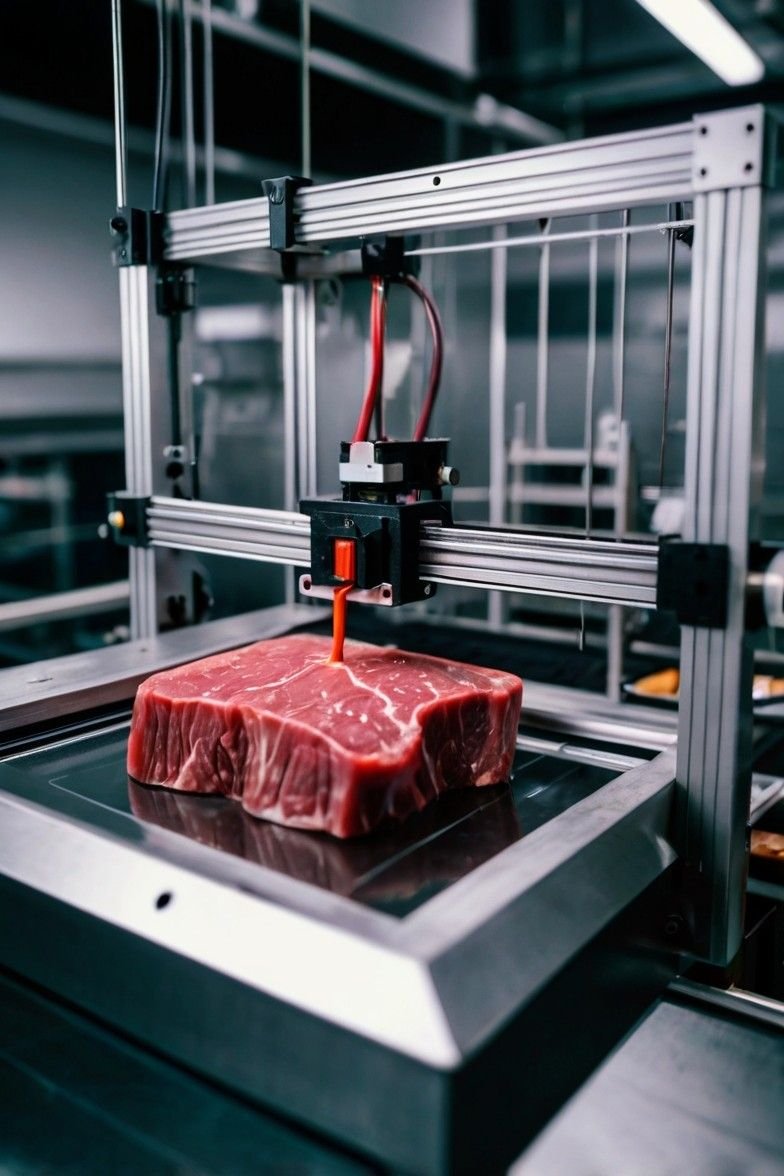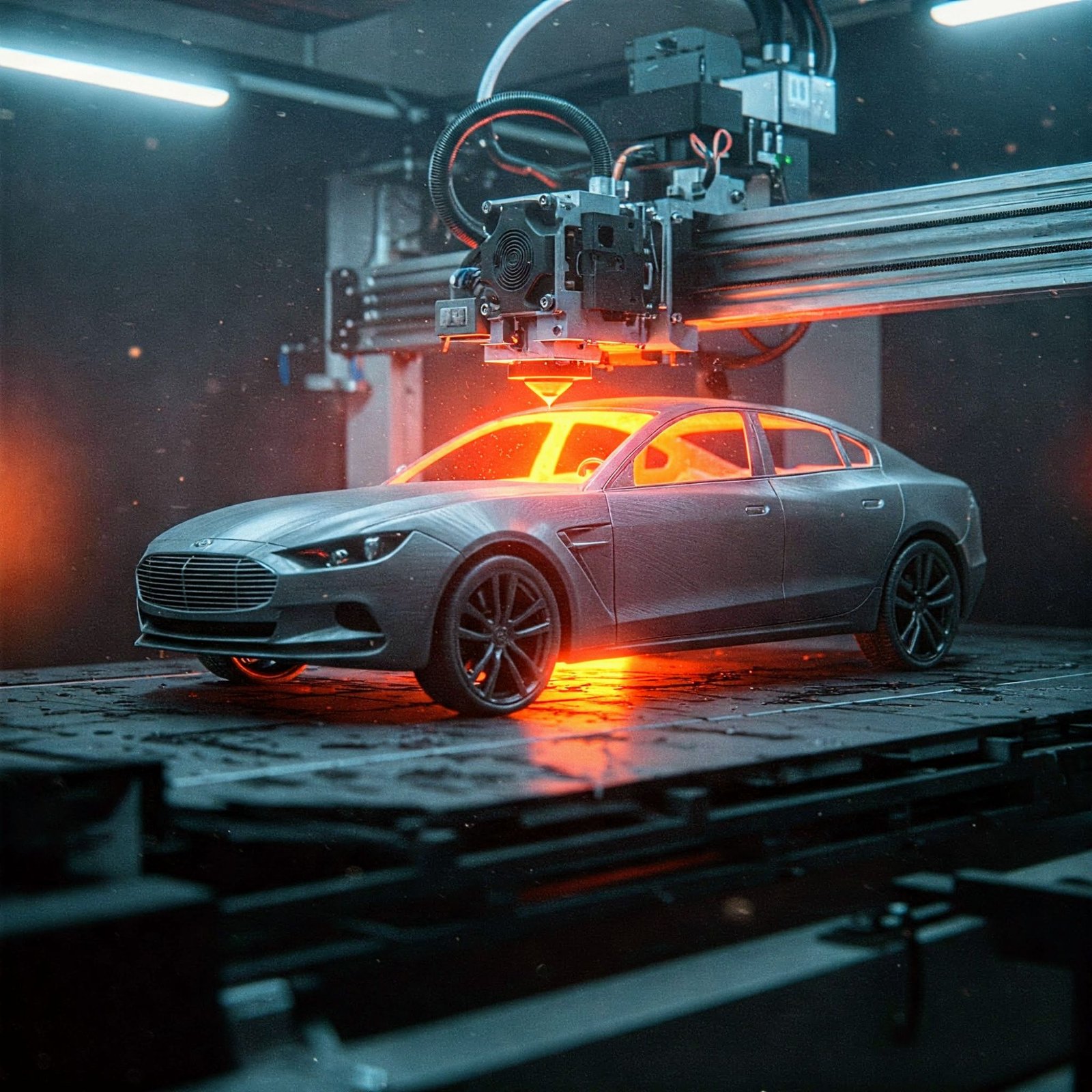AI-Generated Image. Article: 3D Printed Vegan Steaks Should Be An Essential Part Of Your Diet by Tech Is The Culture
Vegan Food Tech Startups Making Cruelty-Free Steaks
Imagine biting into a juicy, tender steak charred on the outside and pink on the inside only to realize it’s made entirely from plants. No cows were harmed, no methane was emitted, and no compromise was made on flavor. Welcome to the future of food, where 3D-printed vegan steaks are rewriting the rules of plant-based dining.
This isn’t science fiction. Food tech startups are leveraging 3D printing to craft vegan steaks that replicate the texture, taste, and nutritional profile of animal meat minus the ethical and environmental baggage. Let’s dissect why these innovations deserve a prime spot on your plate.
The Tech Behind The Bite (How 3D Printed Vegan Steaks Elevate Plant-Based Meat)
Traditional plant-based meats like Beyond Burger and Impossible Foods have already disrupted the $1.4 trillion meat industry. But 3D printing takes this a step further by solving the texture problem, the Achilles’ heel of early vegan alternatives.
Using precision layering, 3D printers assemble plant proteins, fats, and fibers into intricate structures that mimic muscle tissue. For example, companies like Redefine Meat and NovaMeat use pea protein, beetroot juice, and algae-derived fats to create marbling effects indistinguishable from animal fat. As José del Castillo, co-founder of NovaMeat, explains, “3D printing allows us to control micron-level details, replicating the mouthfeel of a ribeye or sirloin.”
This tech also enables customization. Want a high-protein, low-sodium steak? Adjust the ingredient ratios in the printer’s software. Allergic to soy? Swap it for lentil or faba bean protein. Such flexibility addresses the nutritional shortcomings of mass-produced plant-based meats, which often rely on sodium and saturated fats for flavor.
Health Benefits (Beyond The Hype)
1. Heart-Friendly Nutrition
3D-printed vegan steaks sidestep the cholesterol and excessive saturated fats found in animal meat. For instance, Beyond Steak, a plant-based alternative, contains 0mg of cholesterol and just 1g of saturated fat per serving, compared to 4.5g in beef. By using healthier fats like avocado oil or algae, 3D-printed options can further reduce cardiovascular risks linked to traditional meats.
2. Fortified Micronutrients
Unlike conventional meat, 3D-printed steaks can be engineered with added vitamins (B12, D) and minerals (iron, zinc) to combat common deficiencies in plant-based diets. Imagine a steak that delivers 20% of your daily iron and 30% of your B12 all while tasting like the real deal.
3. Cleaner Labels
Many processed plant-based meats contain additives like methylcellulose or artificial flavor enhancers. 3D printing minimizes the need for these by structuring ingredients naturally. For example, beetroot powder can replace synthetic dyes, and mushroom extract can impart umami without MSG.
4. Gut Health Boost
Plant-based meats made from whole-food ingredients like lentils or jackfruit are rich in fiber, promoting a diverse gut microbiome. 3D printing can integrate prebiotic fibers directly into the steak’s matrix, supporting digestion and immunity.
Why Foodies Are Flocking
The biggest hurdle for vegan meat has always been replicating the sensory experience of animal products. Early veggie burgers often crumbled into a mushy disappointment, but 3D printing changes the game.
Texture: From Mush To Marbling
By layering proteins and fats in precise patterns, 3D printers achieve the fibrous, chewy texture of animal muscle. Spanish startup Novameat, for instance, uses microextrusion technology to create steak-like grain structures from pea and rice proteins. The result? A product that “bleeds” beetroot juice when cut and sizzles on the grill.
Flavor: Science Does Savory
3D printing allows for controlled infusion of natural flavor carriers. Heme iron, a molecule responsible for meat’s metallic tang, can be derived from soybean roots and embedded into plant-based steaks, as seen in Impossible Foods’ products. Meanwhile, fat layers printed with coconut or cocoa butter melt at body temperature, mimicking the rich mouthfeel of animal fat.
Culinary Versatility
Chefs are embracing 3D-printed steaks for their adaptability. They hold up in stir-fries, absorb marinades like tofu, and even caramelize under high heat. As Michelin-starred chef Alexis Gauthier notes, “These steaks aren’t just substitutes; they’re a new category of ingredient.”
Sustainability (The 3D Printed Vegan Steaks That Save The Planet)
Animal agriculture accounts for 14.5% of global greenhouse gas emissions. Switching to 3D-printed vegan steaks could slash this footprint dramatically:
– Resource Efficiency: Producing a plant-based steak requires 75% less water and 95% less land than beef.
– Zero Waste: 3D printers use exact portions of ingredients, minimizing food waste during production.
– Carbon Neutrality: Companies like Redefine Meat claim their products generate 90% fewer emissions than livestock farming.
Moreover, 3D printing decentralizes production. Instead of sprawling farms, compact bioreactors can grow proteins like mycoprotein (used in Quorn) in urban labs, reducing transportation emissions.
The Future Plate (What’s Next For 3D-Printed Vegan Steaks & Other Foods?)
The industry is advancing rapidly. Researchers at Osaka University are experimenting with cultured meat hybrids, blending 3D-printed plant proteins with lab-grown animal cells for hybrid steaks. Meanwhile, Israel’s SavorEat has developed a printer that customizes meals based on diners’ dietary needs—think gluten-free or keto-friendly steaks cooked on demand.
Consumer adoption is rising too. A 2024 survey by GFI found that 62% of flexitarians are willing to try 3D-printed meats, citing curiosity and environmental concerns as key drivers.
A Cut Above The Rest
3D-printed vegan steaks aren’t just a novelty; they’re a necessity. They offer a trifecta of benefits: healthier bodies, happier taste buds, and a healthier planet. While the tech is still evolving, early adopters are already reaping the rewards.
As ethical chef and author Bryant Terry puts it, “The future of food isn’t about sacrificing flavor; it’s about innovating toward something better.” So, the next time you fire up the grill, consider swapping that ribeye for a 3D-printed masterpiece. Your heart, palate, and conscience will thank you.
Ready to redefine your diet? Stay tuned for our hands-on review of the latest 3D-printed vegan steaks hitting the market.
Let us know your thoughts on the subject at techistheculture.bsky.social. Keep ahead of the game with our newsletter & the latest tech news.
Disclaimer: This article contains some AI-generated content that may include inaccuracies. Learn more [here].




Great read! I always enjoy staying updated with the latest in tech through Tech Is The Culture. Their articles are insightful and well-researched. It’s amazing how they cover such a wide range of topics. Do they also feature interviews with industry leaders? German news in Russian (новости Германии)— quirky, bold, and hypnotically captivating. Like a telegram from a parallel Europe. Care to take a peek?